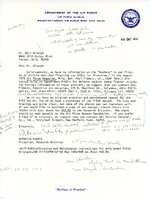Joe Broady
Airman 1st Class
- 112
- May 30, 2019
For these raids, I'm curious if they removed the gun-computer, or kept that. From what I remember, 300 B-29's were built without the gun-computer installed.
Computers, plural. There were five sighting stations (nose, tail, top, left, right) and each had its own computer. The last three had "double parallax" computers because they could control two turrets simultaneously. These computers weighed 130 lb each. The single parallax computers for the nose and tail stations were 25 lb lighter. Four of the five computers were in a well under the gunner compartment floor. The nose computer was above the navigator instrument panel.
"When you are operating in high temperatures give the computer a break. Pull up the floor boards over the computer well for better ventilation." Then as now, computers didn't like to get hot.
B-29 Gunner's Information File (no date)
T. O. No. 11-70A-1, The Central Fire Control System, Handbook of Operation and Service Instructions, 5 December 1944
I think I found that first manual online, maybe at the Army Air Forces Collection. The second one I paid for and it's a monster at 620 MB.

